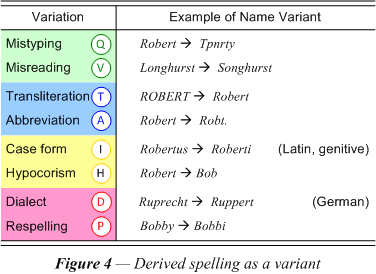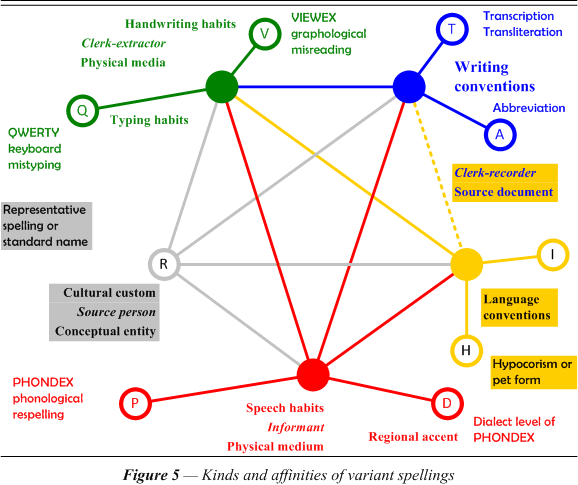
Of great interest to the standardization of name spellings are the derivation types that fail to establish a new name. These derivations result in variants that are caused by clerical exigencies, such as an abbreviation or other kind of shortening of a name. Human error can also occur when a clerk is involved in recording a name, such as respelling because of alternative spelling conventions or dialect variation due to the unusual accent of the informant. The person reading a record could misinterpret the handwriting (misreading) or not translate an inflected form into the citation form (oblique case form). Another cause for variation is the desire to give an individual a special pet form (hypocorism), which usually conveys increased familiarity or endearment of the person so treated.

The kinds of variation in names come in different degrees. To determine the amount of change it is important to come up with a way to measure the change. Some principles of name grouping will lead to possibilites of calculating such metrics.
| 1) Certain variants show greater or lesser affinity to certain other variants. | ||
| 2) Certain variants occur more frequently than certain other variants. | ||
| 3) The frequency of occurrence of each pair of variants is proportional to the affinity of its members. | ||
| 4) It is possible to pool frequencies of variant pairs according to their five orthogonal dimensions (cf. figure 5). |

It was mentioned above that the variant types display partial dependence in a hierarchical tree arrangement. An affinity diagram as in figure 5 shows each of the variant types with colored lines to show this dependence. The paragraphs to follow give more detail about the origin of each of these variants and how they relate to the standard or representative (R) spelling of the name. The most basic are the phonological and all of the variant types seem to relate to these. It is also important to note that there are two main branches of the tree with little room for interaction between the two. It is easy to conceive of maximal variant spelling chains or branches derived in the order: 1) language conventions R-P-D-H-I-V-Q or writing conventions R-P-D-A-T-V-Q. It is difficult, but not impossible to think of examples with both R-P-D-H-I-A-T-V-Q. If a hypocorism and/or an inflectional form has been created, the abbreviation and/or transliteration branch would probably be more likely to be excluded, and vice versa.
